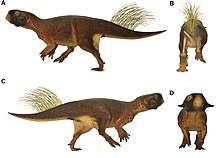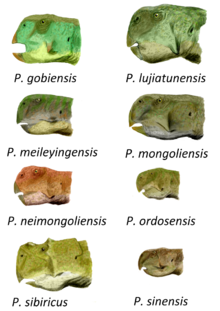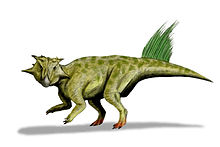Psittacosaurus
| Psittacosaurus | ||||||||||||
|---|---|---|---|---|---|---|---|---|---|---|---|---|

Skeleton reconstruction of Psittacosaurus meileyingensis |
||||||||||||
| Temporal occurrence | ||||||||||||
| Lower Cretaceous ( Hauterivium to Albium ) | ||||||||||||
| 133.9 to 100.5 million years | ||||||||||||
| Locations | ||||||||||||
| Systematics | ||||||||||||
|
||||||||||||
| Scientific name | ||||||||||||
| Psittacosaurus | ||||||||||||
| Osborn , 1923 |
Psittacosaurus is a genus of pelvic dinosaur (Ornithischia) from the group of Ceratopsia . She is one of the most ancient representatives of this group and her fossil record comes from the late Lower Cretaceous in East Asia. With more than ten known species, it is one of the most species-rich genera of dinosaurs.
features
General
Psittacosaurus species were small. The larger ones were around 2 meters in length, while the smaller ones were a third smaller. The weight is estimated at around 20 kilograms. The hind legs were significantly longer than the front legs, and Psittacosaurus probably moved mostly on two legs .
skull

Viewed from above ( dorsal ) the skull of Psittacosaurus is approximately pentagonal. As with all Ceratopsia, the snout is narrow and pointed and the temporal region very broad and expansive, it is formed by lateral processes of the os jugale . At the rear upper side of the head, the parietal bone forms an edge that protrudes over the occiput - the neck shield of later Ceratopsia, consisting of the parietal and scale bone, is not yet present.
Viewed from the side, the skull is roughly rounded and the muzzle short; It is typical for Psittacosaurus that the part of the skull in front of the eye socket makes up less than 40% of the total length. As with all Ceratopsia, the beak-like snout of this dinosaur was characterized by the rostral bone , a bone located in front of the intermaxillary bone at the tip of the upper jaw. This formed the functional counterpart to the Praedentale, the bone in front of the lower jaw, which was present in all pelvic dinosaurs. The muzzle region is thin and stretched out, which is mainly due to the enlarged intermaxillary bone, the nostrils are very high on the head. Overall, this results in the name-giving face shape reminiscent of parrots . Compared to the Neoceratopsia , the more highly developed Ceratopsia, the beak of Psittacosaurus was more rounded. Other features of the skull structure that distinguish this dinosaur from the Neoceratopsia include the closed antorbital window (a skull window in front of the eye socket) and a non-ossified gap in the wall of the tear duct .
teeth
In contrast to the primitive Neoceratopsia, Psittacosaurus had no teeth on the intermaxillary bone . The teeth of the upper and lower jaw were roughly the same size and number, the number varied between eight and twelve. The teeth are characterized by wide chewing surfaces and self-sharpening cutting ends. The teeth were covered with tooth enamel , which was significantly thicker on the buccal (cheek) side of the upper teeth and on the lingual (tongue side) side of the lower teeth than on the opposite sides.
Trunk skeleton

Construction of the spine should in all types of psittacosaurus have been the same: it was composed of 21 before the sacrum located Präsakralwirbeln (eight or nine cervical vertebrae ), six sacral vertebrae and 45 tail vertebrae together. In some species the tail was stiffened by ossified tendons , in others these may have been missing. The shoulder blade was elongated, but the upper arm was short. The hand is characterized by the reduction of the fourth finger and the complete loss of the fifth. The first three fingers are strong and end in hooves. Overall, the front limb is small, reaching only 58% of the length of the hind limb. (In the similarly built basal Neoceratopsia it is around 70%.) The pelvis and the hind limbs are built similarly to other basal Ceratopsia. The lower legs were slightly longer than the thighs. The foot ended in four toes, all of which have wide hooves, with the first toe greatly reduced in size.
Integument
In a Psittacosaurus individual found in China (archive number SMF R 4970), parts of the integument , i.e. the skin, have also been preserved. Most of the body was covered with scales. Larger scales were attached in irregular patterns, with numerous small scales in between. Noticeable was a row of hollow, bristle-like, around 16 centimeters long structures, which stood one behind the other on the top of the tail. These bristles are reminiscent of the proto-feathers discovered in some theropods . However, there is no evidence that these Psittacosaurus bristles were homologous to those of the theropods. Since they were present one behind the other and only on the tail, the bristles should not have had any thermoregulatory functions, but rather played a role in communication - for example when displaying at courtship. In addition, with the help of fossil-preserved melanin residues in the scales, it could be proven that Psittacosaurus had a dark upper side and a light belly side ( counter-shading ) and a coloration that is typical for forest dwellers.
Paleobiology
distribution and habitat
Fossil remains of Psittacosaurus have been found in much of East Asia , from southern Siberia to China to a controversial find from Thailand . These animals are believed to have inhabited a number of habitats. In addition to finds in layers that indicate dry, desert-like habitats , there are also finds in deposits that were created by processes in rivers or lakes.
All Psittacosaurus finds come from the Lower Cretaceous . Most of them can be dated between the Barremian and the Albian and thus to an age of approx. 130 to 100 million years. But there are also older finds that are around 134 million years old.
Locomotion
Due to the structure of the limbs, it is assumed that Psittacosaurus usually walked on two legs ( biped ). The length of the front legs and the construction of the hand do not rule out that these were also used for locomotion purposes. The first finger of the hand was easily opposable and was possibly used for grasping the food.
nutrition
The presumably self-sharpening structure of the teeth suggests hard plant material, the pointed, parrot-shaped beak - as with all Ceratopsia - suggests selective feeding. In contrast to the later Ceratopsidae , the teeth were not yet geared towards thoroughly chewing the food. Instead, over 50 gastroliths (stomach stones) were found in two specimens , which were strikingly large and probably played an important role in the digestion of plant food.
Reproduction and development
Psittacosaurus laid eggs like all dinosaurs. Hatchlings and young animals are known from every stage of growth and show the development of these dinosaurs well. The smallest animals are hatchlings of P. mongoliensis , which are only 11 to 13 centimeters long and have a 2.8 centimeter long skull. The growth rate of these animals was examined in a histological study, the smallest specimens weighed 0.9 kilograms and the largest almost 20 kilograms. The growth phase of a Psittacosaurus was about nine years until the maximum size was reached. This is faster growth than most reptiles, but slower than birds or placental animals .
Another interesting find comes from China. Here the remains of an adult animal with 34 young animals were discovered, all of which were roughly the same age and who died together with the adult in a disaster. This finding could be indicative of parental care for these dinosaurs. The high number of juveniles could indicate that several females laid their eggs in a common nest, perhaps similar to what happens with ostriches .
Predators
Presumably theropod dinosaurs were predators of Psittacosaurus . In China, the skeleton of Repenomamus , a primitive mammal up to 1 meter long, with the remains of a young Psittacosaurus was found in the abdominal cavity . This is the first indication that Mesozoic mammals also ate dinosaurs.
Systematics
Taxonomy and types
The name Psittacosaurus comes from Henry Fairfield Osborn , an American paleontologist. It is derived from the Greek words ψιττακός (psittakos) = "parrot" and σαῦρος (sauros) = "lizard" and is an allusion to the parrot-like beak. The type species was P. mongoliensis , meanwhile over ten species are known. Thus, Psittacosaurus is one of the most species-rich dinosaur genera (apart from birds). In total, the remains of over 400 individuals were found, which allows a more detailed taxonomic investigation of the individual finds, as only one find and thus one species is known of many other dinosaurs. The individual species differ in the structure of the skull and teeth, in the size and, in some cases, in the structure of the pelvis .
- Psittacosaurus guyangensis was discovered in the Lisangou Formation in China's Inner Mongolia Autonomous Regionand described by Cheng in 1983. The fragmentary remains of four animals, including one with a partially preserved skull, are known. The specific epithet is derived from Guyang County, the finds aredatedto the Aptium or Albium . Sometimes P. guyangensis is not regarded as a separate species, but as a synonym for P. mongoliensis .
- Psittacosaurus lujiatunensis was described by Zhou, Gao, Fox and Chen in 2006. The find comes from the Yixian Formation in Liaoning and was named after the nearby village of Lujiatun. The skulls found were 19 to 21 centimeters long, making P. lujiatunensis comparable in size to P. mongoliensis . The finds aredatedto the early Hauterivian (around 134 million years ago), making P. major one of the oldest representatives of the genus.
- Psittacosaurus major is the youngest described species. Its remains also come from the Yixian Formation and were first described in 2007 by Sereno, Zhao, Brown and Tan. The species is known from an almost complete skeleton including skull. Characteristic of this species is the large skull, which is 30% larger than that of mongoliensis . The finds aredatedto the early Aptium . After comparing the skull morphology, P. major was synonymous with Psittacosaurus lujiatunensis in mid-2013.
- Psittacosaurus mazongshanensis was a rather smaller representative, the remains of which werediscovered in Gansu Provinceand described in 1997. The name comes from the Mazong-Shan mountains there. The relatively long snout was characteristic of this species. The exact date is controversial, the find may come from the Barremium .
- Psittacosaurus meileyingensis comes from the Jiufotang Formation in Liaoning and was described in 1988, the specific epithet reflects the location. The species is characterized by a high skull and a very short snout. The age is dated to the early Aptium .
- Psittacosaurus mongoliensis is the type species . The first remains come from the Öwörchangai-Aimag in Mongolia , further fossils have been found all over Mongolia and some places in northern China. A total of over 75 individuals are known, of which more than 15 are trunk skeletons. P. mongoliensis was one of the largest species with a length of around 2 meters; the findings come from the Aptium and Albium . The initially as an independent genre Protiguanodon and later as a kind psittacosaurus protiguanodonensis are now described findings as conspecific with P. mongoliensis .
- Psittacosaurus neimongoliensis is named after Inner Mongolia's Chinese name, nei mongol . The species was first described by Russell and Zhao in 1996 and comes from the Ejinhoro Formation in this province. In addition to differences in the skull, this species is also characterized by an elongated ischium , part of the pelvis.
- Psittacosaurus ordosensis comes from the same formation as P. neimongoliensis and was also described by Russell and Zhao in 1996. It is named after the Ordos region, but only known from parts of the skull. It was a very small species, characterized by prominent cheek humps.
- Psittacosaurus osborni was discovered in the Lisangou Formation in Inner Mongolia and wasfirst describedby CC Young in 1931. The specific epithet honors Henry Fairfield Osborn , who was the first to describe Psittacosaurus . The species lived in the Aptium or Albium . The species P. tingi ,which was initially described as an independent species,is likely to be a synonym for P. osborni ; sometimes the species is also considered to be conspecific with P. mongoliensis .
- Psittacosaurus sattayaraki wasdiscoveredin Thailand and first described in 1992. The finds are limited to a fragment of the upper jaw and a partially preserved lower jaw. In many cases the finds are considered insufficient for an exact determination and P. sattayaraki as a nomen dubium . It would be the southernmost find of the genus Psittacosaurus, otherwise known only from Siberia, Mongolia and China.
- Psittacosaurus sibiricus wasdiscoveredin the Kemerovo Oblast in Siberia as early as the 1950s, but initially thought to be P. mongoliensis . It was not until the beginning of the 21st century that the finds were described as a separate species. P. sibiricus was one of the largest species and was characterized by the relatively large neck shield, the broad cheek humps and several bony humps around the eye.
- Psittacosaurus sinensis was discovered in the Qingshan Formation in the Chinese province of Shandong and was first described by CC Young in 1958. Over 20 individuals of this species are known, including five complete skulls. It was a smaller species with fewer teeth, but the cheekbones were very broad.
- Psittacosaurus xinjiangensis is named after the Chinese Xinjiang in which the species was discovered. The first description was by Sereno and Chao in 1988, a total of more than 10 individuals are known. The species is dated to the Aptium or Albium .
- Psittacosaurus youngi is named after the paleontologist CC Young and was described in 1962. The finds come from the same formation as P. sinensis , possibly the same species.
- Psittacosaurus gobiensis from Inner Mongolia was first described in 2009. The species shows signs of a nut diet.
In addition to these described species, there are numerous finds of Psittacosaurus that have not been assigned to any species, for example because the finds are too sparse or a detailed description is still pending.
External system
The genus Psittacosaurus is counted within the Ceratopsia to the Psittacosauridae , which also includes only the little known genus Hongshanosaurus . Apart from the primitive Yinlong , the Psittacosauridae form the sister group of the other Ceratopsia, which are summarized as Neoceratopsia . This is expressed in the following cladogram:
| Ceratopsia |
|
||||||||||||
|
|
The position of Chaoyangsaurus and the closely related Xuanhuaceratops is controversial .
literature
- You Hailu, Peter Dodson : Basal Ceratopsia. In: David B. Weishampel , Peter Dodson, Halszka Osmólska (eds.): The Dinosauria . 2nd edition. University of California Press, Berkeley CA et al. 2004, ISBN 0-520-24209-2 , pp. 478-493, digitized version (PDF; 807.25 kB) .
Web links
Individual evidence
- ^ Gregory S. Paul : The Princeton Field Guide To Dinosaurs. Princeton University Press, Princeton NJ et al. 2010, ISBN 978-0-691-13720-9 , pp. 246-249, online .
- ↑ Gerald Mayr , Stefan D. Peters, Gerhard Plodowski, Olaf Vogel: Bristle-like integumentary structures at the tail of the horned dinosaur Psittacosaurus. In: The natural sciences. Vol. 89, No. 8, 2002, pp. 361-365, ISSN 0028-1042 , digitized version (PDF; 223.87 kB) .
- ↑ Jakob Vinther et al. 2016. 3D camouflage in an Ornithischian Dinosaur. Current Biology 26: 1-7; doi: 10.1016 / j.cub.2016.06.065
- ↑ Gregory M. Erickson, Tatyana A. Tumanova: Growth curve of Psittacosaurus mongoliensis Osborn (Ceratopsia: Psittacosauridae) inferred from long bone histology. In: Zoological Journal of the Linnean Society. Vol. 130, No. 4, 2000, ISSN 0024-4082 , pp. 551-566, doi : 10.1111 / j.1096-3642.2000.tb02201.x .
- ↑ Qingjin Meng, Jinyuan Liu, David J. Varricchio, Timothy Huang, Chunling Gao: Parental care in an ornithischian dinosaur. In: Nature . Vol. 431, No. 7005, 2004, pp. 145-146, doi : 10.1038 / 431145a .
- ↑ Brandon P. Hedrick, Peter Dodson: Lujiatun Psittacosaurids: Understanding Individual and Taphonomic Variation Using 3D Geometric Morphometrics. In: PLoS ONE . Vol. 8, No. 8, 2013, e69265, doi : 10.1371 / journal.pone.0069265 .
- ↑ Paul C. Sereno , Zhao Xijin , Tan Lin: A new psittacosaur from Inner Mongolia and the parrot-like structure and function of the psittacosaur skull. In: Proceedings of the Royal Society. Series B: Biological sciences. Vol. 277, No. 1679, 2010, ISSN 0950-1193 , pp. 199-209, doi : 10.1098 / rspb.2009.0691 .




